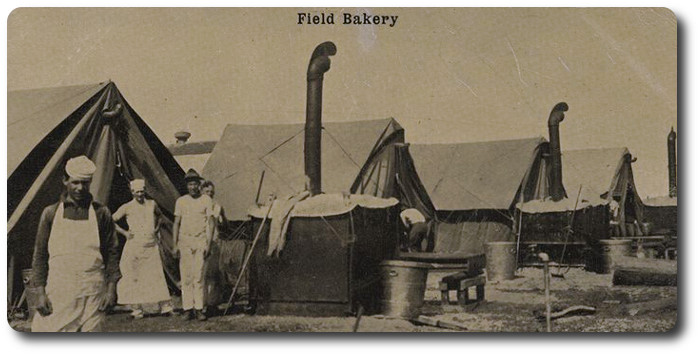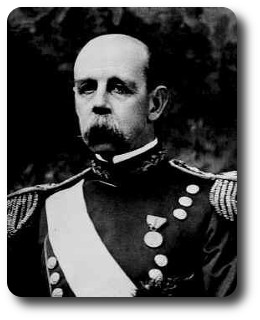Topic: Army Rations

Feeding Uncle Sam's Big Army
Hot Meals at All Hours
Illustrated Sunday Magazine, The Gazette Times, Pittsburgh, 23 June 1907
By: Brig.-Genl. Henry G. Sharpe, Commissary General, U.S.A.
 The Commissary Department of the Army of the United States has been brought to perfection and the American soldier is better fed than the man who bears arms under any other flag on earth.
The Commissary Department of the Army of the United States has been brought to perfection and the American soldier is better fed than the man who bears arms under any other flag on earth.
Veterans of the Civil War will recall the doggerel in which the fare of the boys who wore blue was designated. It was:
Beans for breakfast;Beans for dinner;
Beans for supper;
Beans, Beans, Beans!
The men who followed the stars and bars were not so fortunate as to have a regular diet of even beans. The frequently subsisted for weeks at a time on a few pounds of parched corn, and they fought well under that diet, too. But for years now the best thought of the commissaries of the army has been devoted to the improvement of the food conditions and Brigadier-General Henry G. Sharpe, Commissary-General of the Army, has prepared the following article for the Illustrated Sunday magazine on the food of the Army, in which he gives some interesting data concerning the method of feeding Uncle Sam's defenders,

While in garrison the enlisted man in the United States Army is entitled to draw each day twenty ounces of fresh beef or mutton, or twelve ounces of bacon. Should it be found impracticable to obtain fresh meat he has in lieu thereof sixteen ounces of canned meat, or canned fish, fourteen ounces of dried fish, or sixteen ounces of pickled fish. He may, on occasion, draw from the commissary and can of beef and vegetable stew containing twenty-eight and one-half ounces. He is entitled each day to eighteen ounces of flour or its equivalent in bread, or in lieu thereof twenty ounces of corn meal.
Of vegetable components he has his choice of beans, peas, rice and hominy and a pound of potatoes, onions or canned tomatoes. In addition thereto he is supplied each day with about an ounce and a half of prunes, evaporated apples or peaches. An ounce and a third of roasted coffee or a third of an ounce of tea is given to each man we well as a little more than three ounces of sugar, and a sufficient quantity of vinegar, pepper and salt.
This is the ordinary garrison ration. When located at army posts convenient to city markets the mess may exchange any portion of its rations for fresh vegetables, fruits or other delicacies which strike the fancy.
The field ration differs in its essential particulars only slightly from that issued in garrison. Jam takes the place of dried fruits and with each portion of flour is supplied baking powder or yeast.
It has been the aim of the Department for some time past to improve the method of feeding the troops in the field. With this end in view a school of cookery has been established at Fort Riley, Kansas, with branches at the Presidio in California and at the Washington Barracks, District of Columbia. The men at these schools are instructed in the art of baking bread of various kinds and in general plain cookery, the idea being to establish a corps of army cooks who can take the ordinary rations and prepare them in such a manner as to tempt the appetite of the enlisted men. The result of this training is that the army cooks today are able to prepare meals out of the supplies furnished to each mess which would do credit to an ordinary hotel. The receipts used in these cooking schools embrace a dozen different soups, five or six methods of preparing fish and oysters, ten or twelve sauces and gravies, besides fifty or more ways of serving the various meals and vegetables which are furnished as regular rations, to say nothing of the numerous methods of making different kinds of breads, cakes, muffins, puddings and pies. In short the men of the army today, when in garrison, are better served than the men in civil life in like conditions.
The army cooking schools will result in the ultimate establishment of a corps of cooks and bakers capable of preparing appetizing meals at all times for the troops of the Unites States and will assure to them better and more varied food than the soldiers of any other country can hope to have. Still we are up to the present time behind the European armies in the matter of movable ovens. At the outbreak of the Spanish War such contrivances were practically unknown to the Army. Out soldiers were compelled to depend largely upon hard tack for their bread, although the German and French armies had adopted the movable oven long before that time. And even now we have few of these very necessary adjuncts to the Commissary Department although it is likely that under new regulations, recently adopted, these will soon be supplied.
One of the longest steps forward in the way of providing for the men of the army on the march is now being perfected by this department. That is the construction of what is generally known as "the fireless cooker," a modification of the Norwegian hay-oven. For two or three years past we have been experimenting with a view to the adoption of the best possible method for supplying hot meals to the troops in the field in the quickest possible time. The fireless cooker, or hay-oven, is no new thing. It has been used in Europe for a great many years. The main idea is to partially cook a meal and then to place the food in a receptacle that will retain the heat, with as little loss as possible, and to permit the retained heat to finish the coking operations. Everybody knows that water boils at two hundred and twelve degree Fahrenheit, but very few people realize that water never gets any hotter than that and few even seem to know that it is unnecessary to bring food up to even the degree of temperature required to boil water provided the heat can be retained, to insure perfect cooking.
Experiments have shown that partially cooked food can be thoroughly cooked if kept at a temperature anywhere above 170 for a certain period of time and that is what is being done with the fireless cooker, which we hope to be able to perfect so as to make it available for the army.
There are in the market today a great many such appliances, ranging from wooden boxes, packed with asbestos of mineral wool, up to elaborate metallic contrivances, several inches thick in the rim packed with some sort of non-conductor of heat, such as wood fibre or asbestos. What the army wants is a contrivance of this character in which partially cooked foods may be placed which will retain heat for many hours and to this end our experiments are being made with a fair degree of success thus far. Not long ago a squad of men started on a march from Fort Riley, Kansas, followed by a wagon containing a partially cooked meal; sufficient for the entire squad. After a march of six hours the fireless cooker in which this meal was contained was opened and it was found that the meat, vegetables, and macaroni, contained therein was perfectly prepared and ready for dinner.
The theory is a simple on. It is that heat retained by a non-conductor and prevented from escaping will complete the operation of cooking food. The hay-box of Norway has been used for a generation or more and we want to adopt the idea into the army of the United States; when this is done a squad of troops started out on a day's march can be followed by supply wagons with fireless cookers, they have been packed when camp is broken in the morning, and will have a nutritious hot meal ready to serve to them immediately when camp is made again at night.
Heretofore it has been found necessary in order to give our soldiers hot food on a march to carry a supply of fuel from camp to camp. And even then a great deal of time is consumed in building the fires and in cooking the meals. It will be readily understood that any method which promises the elimination of the necessity of hauling large quantities of fuel and at the same time eliminate the loss of time will be of enormous advantage and that the result will be highly appreciated by the men to be fed.
Manufacturers have in many instances prepared devices which are entirely satisfactory in a small way and which appear to be excellent for domestic purposes but up to the present time none of them has designed a "fireless cooker" satisfactory for the needs of such a number of men as the Subsistence Department must provide for. We are looking for lightness in weight, combined with an absolute stability in construction. We want a cooker that will stand long travel over all sorts of roads and assure the perfection of the contents at the end of the journey. Each receptacle containing foods must be absolutely air tight, easily cleansed and readily adjusted. We have secured, through our own officers, several devices which seem to fill the bill and I am confident that before long it will be possible to start out a regiment of soldiers from camp in the morning with a wagon containing fireless cookers supplied with a full ration of partially cooked food which will be fit to serve in the form of a palatable well cooked meal by the time camp is reached at the end of the day.

